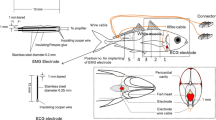Abstract
Swimming performance of jack mackerel Trachurus japonicus (18.2 ± 0.8 cm fork length (FL), n = 185) was examined in a flume tank by measuring the stride length at low and high tail beat frequencies with electromyogram monitoring and a muscle twitch experiment. Stride length was analyzed by monitoring the tail beat frequency according to the swimming speed at different temperatures of 10, 15 and 22 °C. In the electromyographic observations, the initiation of ordinary muscle activity occurred between 71.4 and 99.6 cm/s, that is 3.7 to 5.3 FL/s, when the tail beat frequency was over 6 Hz. The swimming speeds increased rectilinearly with the tail beat frequency at each water temperature both for the low and high tail beat frequency. Lower stride length was observed at the lowest temperature (10 °C) tested. The forced swimming exercise significantly affected the muscle contraction time to become longer than the control fish, which indicated a reduction of the maximum swimming speed performance.







Similar content being viewed by others
References
He P (2008) Swimming capacity of marine fishes and its role in capture by fishing gears. In: Domenici P, Kapoor BG (eds) Fish locomotion: an eco-ethological perspective. Science Publisher, Enfield, pp 484–512
Wardle CS (1986) Fish behavior and fishing gear. In: Pitcher TJ (ed) The behavior of teleost fishes. Croom Helm, London, pp 463–495
He P (1993) Swimming speeds of marine fish in relation to fishing gears. ICES Mar Sci Symp 196:183–189
Rome LC, Swank D (1992) The influence of temperature on power output of scup red muscle during cyclical length changes. J Exp Biol 171:261–281
Rome LC, Choi IH, Lutz G, Soznicki A (1992) The influence of temperature on muscle function in the fast swimming scup. I. Shortening velocity and muscle recruitment during swimming. J Exp Biol 163:259–279
Wardle CS (1975) Limit of fish swimming speed. Nature 255:725–727
Wardle CS (1977) Effect of size on the swimming speed of the fish. In: Pedley TJ (ed) Scale effects in animal locomotion. Academic Press, London, pp 299–313
Wardle CS (1980) Effect of temperature on the maximum swimming speed of fishes. In: Ali AM (ed) The environmental physiology of fishes. Plenum, New York, pp 519–531
Brill RW, Dizon EA (1979) Effect of temperature on isotonic twitch of white muscle and predicted maximum swimming speed of skipjack tuna, Katsuwonus pelamis. Env Biol Fish 4:199–205
Videler JJ, Wardle CS (1991) Fish swimming stride by stride: speed limits and endurance. Rev Fish Biol Fish 1:23–40
Randal D, Brauner C (1991) Effect of environmental factors on exercise in fish. J Exp Biol 160:113–126
Özbilgin H, Wardle CS (2002) Effect of seasonal temperature changes on the escape behaviour of haddock Melanogrammus aeglefinus, from the codend. Fish Res 58:323–331
Arimoto T, Xu G, Matsushita Y (1993) Muscle contraction time of captured walleye pollock Theragra chalcogramma. Nippon Suisan Gakkashi 57:1225–1228
Xu G, Arimoto T, Inoue M (1993) Red and white muscle activity of the jack mackerel Trachurus japonicus during swimming. Nippon Suisan Gakkaishi 59:745–751
Amornpiyakrit T, Arimoto T (2007) Muscle physiology on escape response of kuruma shrimp. Am Fish Soc Symp 49:587–599
Xu G, Arimoto T, Inoe M (1988) The measurements of swimming speed in jack mackerel Trachurus japonicus. Nippon Suisan Gakashi 54:1493–1497 (in Japanese with English abstract)
Nofrizal Yanase K, Arimoto T (2009) Effect of temperature on the swimming endurance and post-exercise recovery of jack mackerel Trachurus japonicus as determined by ECG monitoring. Fish Sci 75:1369–1375
Jain KE, Farrel A (2003) Influence of seasonal temperature on the repeat swimming performance of rainbow trout Oncorhynchus mykiss. J Exp Biol 206:3569–3579
Beamish FWH (1984) Swimming performance of three southwest Pacific fishes. Mar Biol 79:311–313
Brett JR (1964) The respiratory metabolism and swimming performance of young sockeye salmon. Fish Res Board Can 21:1183–1226
Yanase K, Eayrs S, Arimoto T (2007) Influence of water temperature and fish length on the maximum swimming speed of sand flathead, Platycephalus bassensis: implications for trawl selectivity. Fish Res 84:180–188
Videler JJ (1993) Swimming dynamics: exchange of forces between fish and water. In: Videler JJ (ed) Fish swimming. Chapman and Hall, London, pp 165–184
Wardle CS, Videler JJ, Arimoto T, Franco JM, He P (1989) The muscle twitch and maximum swimming speed of giant bluefin tuna Thunnus thynnus L. J Fish Biol 35:129–137
Wardle CS, He P (1988) Burst swimming speed of mackerel Scomber scombrus L. J Fish Biol 32:471–478
Inoue Y, Matsushita Y, Arimoto T (1993) The reaction of walleye pollock (Theragra chalcogramma) in a deep/low-temperature trawl fishing ground. ICES Mar Sci Symp 196:77–79
Kieffer JD (2000) Limit to exhaustive exercise in fish. Comp Biochem Physiol 126:161–179
Xu G, Arimoto T, Inoue Y (1993) The measurement of muscle fatigue in walleye pollock (Theragra chalcogramma) captured by trawl. ICES Mar Sci Symp 196:117–121
Chopin SF, Arimoto T, Inoue Y (1996) A comparison of the stress response and mortality of sea bream Pagrus major captured by hook and line and trammel net. Fish Res 28:277–289
Author information
Authors and Affiliations
Corresponding author
Rights and permissions
About this article
Cite this article
Riyanto, M., Yanase, K. & Arimoto, T. Temperature and fatigue effect on the maximum swimming speed of jack mackerel Trachurus japonicus . Fish Sci 80, 53–59 (2014). https://doi.org/10.1007/s12562-013-0686-6
Received:
Accepted:
Published:
Issue Date:
DOI: https://doi.org/10.1007/s12562-013-0686-6




